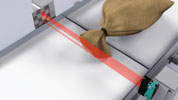

A new retro-reflective area sensor with a total of six beams has proven to be the ideal solution for many application areas where single-beam sensors are currently used and have reached their limitations.
The sensor is mechanically and electrically compatible with conventional standard optical sensors available on the market and ensures that all detection processes run consistently and reliably, even if the shape, surface and positions of the object vary.
Many detection objects are similar but not identical
Pallets can be found in almost every establishment where goods are handled, delivered or transported. However, the types of pallet available on the market are more heterogeneous than they are standardised. On the one hand, they have different designs, materials and manufacturing qualities, and on the other they are subject to constant wear caused by the heavy loads experienced on a daily basis in industrial environments. Euro pallets, half pallets, Düsseldorf pallets, chemical pallets, disposable pallets and many other types of pallet vary in height and have different reflection characteristics.
More specifically, the varying front edges of pallets or conveyed goods easily mislead standard optical sensors with single-point detection characteristics. The main causes of potential confusion include irregularities ranging from minor damage and ageing to missing pieces or even missing boards. In the case of Düsseldorf pallets, there is also a possibility that the special metal spacers will reflect the light beam directly. If conventional single-beam retro-reflective sensors are used in situations of this kind and the reflectors are not obscured properly by the object, the light beam is only partially interrupted, the pallet is not detected or detected late and incorrect switching occurs.
Six light beams can detect more
The new RLG28 retro-reflective area sensor by Pepperl+Fuchs presents an efficient solution for identical or similar problems. The RLG28 uses a total of six parallel light beams to form a constant, uninterrupted 60 mm high detection area within a sensing range between 0 and 4 m together with the reflector positioned opposite. The output of the photoelectric sensor is activated as soon as the evaluation electronics detect that the sum signal has decreased by more than 10%. Objects with an obstacle size greater than 12 mm are detected and the resolution remains constant throughout the detection area. The RLG28 enables the consistent detection of larger, smaller and even misshapen objects while at the same time commanding a high degree of tolerance to frequent modifications, damage or deficiencies similar to those that occur during the transport of pallets.
Compatible with standard photoelectric sensor housings and connections
One particular user benefit is the integration of technology in a compact standard photoelectric housing that has already established itself on the market and among many companies. Due to the mechanical and electrical compatibility, conventional photoelectric sensors can be replaced one to one with the new retro-reflective area sensor without having to modify the control concept or the wiring. Existing reflectors can continue to be used.
The device combines outstanding sensor performance with a modern operating and display concept compliant with European display standard F25. Bright thin-film LEDs produce a well illuminated homogeneous surface. The clearly visible red light enables simple alignment during installation and thorough visual inspections during testing and commissioning. The output signal is available at two push-pull outputs and can be switched between light-on and dark-on. The response time is 1 ms at a switching frequency of 250 Hz. System characteristics during operation include a high degree of immunity to extraneous light, foil and reflection resistance, resistance to vibrations and shaking and protection against mutual interference. Bright clearly visible indicator LEDs provide detailed information on the operating and switching status for the benefit of personnel.
A step in the direction of fault tolerant detection
An important step has been taken in the direction of fault tolerant detection with the development of the new retro-reflective area sensor – six light beams detect better than one. The concept of the retro-reflective area sensor solves the problem of unreliable object detection under the harsh and changing conditions that are experienced on a daily basis in real industrial environments. The sensor can master problematic materials and situations where the appearance of the object changes or becomes misshapen as well as render realignment and adjustment tasks superfluous when changing batches and loads.
IP67 protection, resistance to reflection and vibrations and a reliable operating temperature range of -30 to 60°C open up a wide variety of applications in the material handling, packaging and automotive industries. Specialised for the reliable detection of object front edges and continuous object detection, RLG28 retro-reflective area sensors are not only suitable for a large selection of pallets, but also bags or other objects without a clearly defined shape, packaged objects or as an overhang monitor or a muting sensor. The texture of the object no longer plays a role and so the ejection control also detects falling objects with a high degree of reliability and consistency.
| Tel: | +27 10 430 0250 |
| Email: | [email protected] |
| www: | www.pepperl-fuchs.com/en-za |
| Articles: | More information and articles about Pepperl+Fuchs |

© Technews Publishing (Pty) Ltd | All Rights Reserved